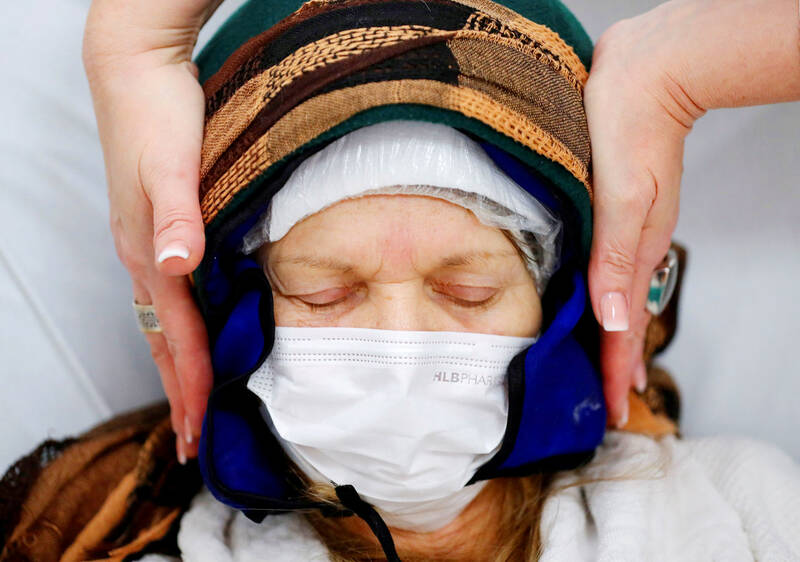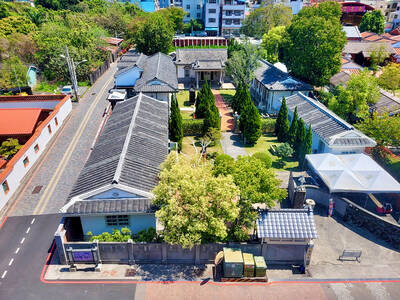Doctors have told health services to prepare for a new era of cancer screening after a study found a simple blood test could spot multiple cancer types in patients before they develop clear symptoms.
The Pathfinder study offered the blood test to more than 6,600 adults aged 50 and over, and detected dozens of new cases of disease. Many cancers were at an early stage and nearly three-quarters were forms not routinely screened for.
It is the first time results from the Galleri test, which looks for cancer DNA in the blood, have been returned to patients and their doctors, to guide cancer investigations and any necessary treatment.

Photo: REUTERS
The Galleri test has been described as a potential “gamechanger” by NHS England, which is due to report results from a major trial involving 165,000 people next year. Doctors hope the test will save lives by detecting cancer early enough for surgery and treatment to be more effective, but the technology is still in development.
“I think what’s exciting about this new paradigm and concept is that many of these were cancers for which we do not have any standard screening,” Deb Schrag, a senior researcher on the study at the Memorial Sloan Kettering Cancer Center in New York, told the European Society for Medical Oncology meeting in Paris on Sunday.
In the Pathfinder study, 6,621 adults aged 50 and over were offered the Galleri blood test. For 6,529 volunteers, the test was negative, but it flagged a potential cancer in 92.
Further tests confirmed solid tumors or blood cancer in 35 people, or 1.4 percent of the study group. The test spotted two cancers in a woman who had breast and endometrial tumors.
Beyond spotting the presence of disease, the test predicts where the cancer is, allowing doctors to fast-track the follow-up work needed to locate and confirm a cancer.
“The signal of origin was very helpful in directing the type of work-up,” Schrag said. “When the blood test was positive, it typically took under three months to get the work-ups completed.”
The test identified 19 solid tumors in tissues such as the breast, liver, lung and colon, but it also spotted ovarian and pancreatic cancers, which are typically detected at a late stage and have poor survival rates.
The remaining cases were blood cancers. Out of the 36 cancers detected in total, 14 were early stage and 26 were forms of the disease not routinely screened for.
Further analysis found the blood test was negative for 99.1 percent of those who were cancer-free, meaning only a small proportion of healthy people wrongly received a positive result. About 38 percent of those who had a positive test turned out to have cancer.
Schrag said the test was not yet ready for population-wide screening and that people must continue with standard cancer screening while the technology is improved.
“But this still suggests a glimpse of what the future may hold with a really very different approach to cancer screening,” she said.
Fabrice Andre, the director of research at Gustave Roussy cancer center in Villejuif, France, said: “Within the next five years, we will need more doctors, surgeons and nurses, together with more diagnostic and treatment infrastructure, to care for the rising number of people who will be identified by multi-cancer early detection tests.”
Naser Turabi, the director of evidence and implementation at Cancer Research UK, said: “Blood tests for multiple types of cancer used to belong in the realm of science fiction, but now they are an area of cancer research that is showing promise for patients.”
He added that research like this is crucial for making progress against late-stage cancers and giving more patients the chance of a good outcome. The Pathfinder trial results offer a better understanding of how frequently cancer is found by this blood test in people who haven’t been previously diagnosed.
“But we will need data from larger studies to fully assess this test and other similar tests in development, especially to understand whether people actually survive for longer after their cancer is picked up,” Turabi said.

April 28 to May 4 During the Japanese colonial era, a city’s “first” high school typically served Japanese students, while Taiwanese attended the “second” high school. Only in Taichung was this reversed. That’s because when Taichung First High School opened its doors on May 1, 1915 to serve Taiwanese students who were previously barred from secondary education, it was the only high school in town. Former principal Hideo Azukisawa threatened to quit when the government in 1922 attempted to transfer the “first” designation to a new local high school for Japanese students, leading to this unusual situation. Prior to the Taichung First

Chinese Nationalist Party (KMT) Chairman Eric Chu (朱立倫) hatched a bold plan to charge forward and seize the initiative when he held a protest in front of the Taipei City Prosecutors’ Office. Though risky, because illegal, its success would help tackle at least six problems facing both himself and the KMT. What he did not see coming was Taipei Mayor Chiang Wan-an (將萬安) tripping him up out of the gate. In spite of Chu being the most consequential and successful KMT chairman since the early 2010s — arguably saving the party from financial ruin and restoring its electoral viability —

The Ministry of Education last month proposed a nationwide ban on mobile devices in schools, aiming to curb concerns over student phone addiction. Under the revised regulation, which will take effect in August, teachers and schools will be required to collect mobile devices — including phones, laptops and wearables devices — for safekeeping during school hours, unless they are being used for educational purposes. For Chang Fong-ching (張鳳琴), the ban will have a positive impact. “It’s a good move,” says the professor in the department of

Toward the outside edge of Taichung City, in Wufeng District (霧峰去), sits a sprawling collection of single-story buildings with tiled roofs belonging to the Wufeng Lin (霧峰林家) family, who rose to prominence through success in military, commercial, and artistic endeavors in the 19th century. Most of these buildings have brick walls and tiled roofs in the traditional reddish-brown color, but in the middle is one incongruous property with bright white walls and a black tiled roof: Yipu Garden (頤圃). Purists may scoff at the Japanese-style exterior and its radical departure from the Fujianese architectural style of the surrounding buildings. However, the property